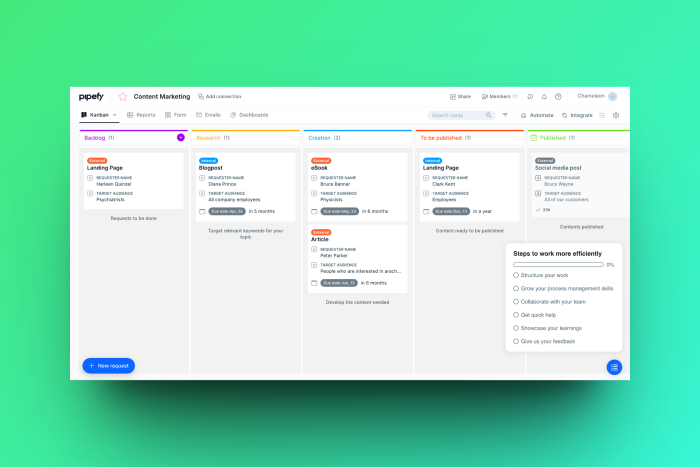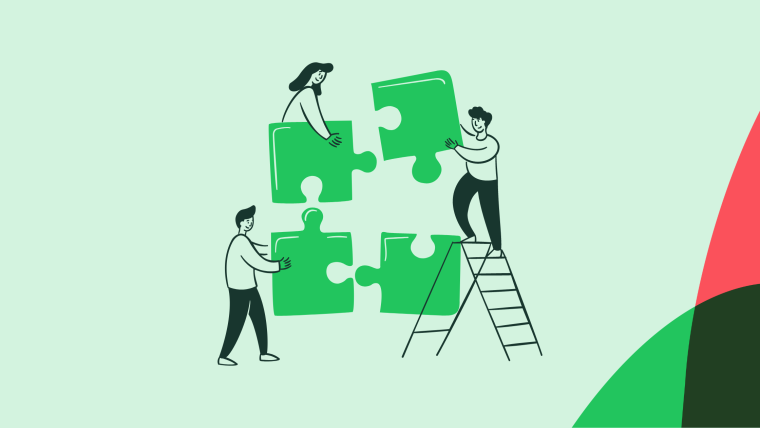SaaS growth pathways have come a long way over the years. First, we had sales-led growth, then, marketing-led growth, and today many are at product-led growth. Product-led growth is when SaaS companies build their businesses by relying on their product to do the heavy lifting.
Product-led growth is notoriously more scalable than sales- or marketing-led growth, and enables businesses to channel more efforts and priorities into the growth and maintenance of their product—which is what your customers will be using every day—rather than building extravagant marketing flows and sales cycles, which only serve to acquire customers.
By shifting to product-led growth, you shift into focusing on retaining customers first, which in turn, supports your acquisition efforts.
Yet, what should a product-led growth plan actually look like? Buckle up, in this article we’re exploring product-led planning, product-led OKRs, essential PLG principles, and the build of a successful PLG strategy.
There are eight PLG principles to consider:
A strong product-led growth plan starts with in-app customer research and ends with a North Star metric.
There are four types of PLG funnels you can use: bottom-up, top-down, self-serve, and assisted funnels.
Product-led growth is a good idea for most SaaS businesses with limited resources.
1. Offer a try before you buy (free trial) experience
Or, more commonly referred to in SaaS as a free trial. This PLG principle is key to getting your product into the hands of keen users, and it’s one we use here at Chameleon!
Providing you’ve got a solid in-app user experience, you should have no problem converting your free trial users at the end of their free trial period.
Most SaaS run a 2-week to 1-month free trial period. This should be enough time for users to discover their ‘Aha! Moment”—more on this later—and enough time for them to embed your tool into their day-to-day tech stack—evolving your solution from "nice to have" to "can't live without."
2. Highlight a simple value proposition at the start of the user journey
Right off the bat, you want your users nodding along, muttering, "yep, that's exactly what I need." Boil down all the amazing things your product can do into a simple, punchy, sticky statement.
Imagine meeting someone at a coffee shop and you've got just one sentence to make them go, "Wow, tell me more!" That's your value prop.
You’re probably thinking isn't this sort of like the 'Aha! moment'? Not exactly. Your value prop is what gets people through the door, sparking that initial curiosity. The 'Aha! moment' is when everything clicks—the full experience that turns casual interest into excitement.
First, we grab their attention; then, we make the big reveal.
Get inspired from other SaaS using PLG principles for growth
Grab your no-fluff guide to behind-the-scenes growth strategies that helped giants like Dropbox, Zapier, and BuzzFeed acquire millions of new users and increase their MRR.
3. Understand your “Aha!” moment(s)—and deliver them early
Otherwise known as Eureka moments, these are those precious times you get your user to realize the product value. Ideally, you’ll want your user to cry “Eureka!” and throw a fist in the air. Failing that, you’ll want them to mutter “Aha” as they realize the possibilities that can be achieved with your product, how it can aid them in their job-to-be-done, and how it can ultimately make their life easier.
Mixpanel, a product analytics company, brought about these moments by guiding users through new features and updates. As Mixpanel grew and added new features, they needed a way to showcase these changes without losing users in the process.
Mixpanel used Chameleon to create engaging, easy-to-follow product tours. The tours had a 56% finish rate, proving users were not just starting them but sticking with them to the end. The payoff was huge: a 4% increase in customers retention and a Net Promoter Score (NPS) that tripled in 16 months.

4. Focus on the end-user experience
With the value proposition and "Aha!" moments established, your focus should shift to user centricity or the overall user experience—is it positive? Does it address usability, satisfaction, and potential pain points?
Start by mapping out the user journey, from the first interaction to daily usage. Identify potential pain points and moments of delight. Is your sign-up process a breeze or a clunky hurdle? Once logged in, can users find what they need without a scavenger hunt? Use the bowling alley framework to keep users on track: try surveys, chat support, and even emails to tune into their frequency.
Don’t forget a personal touch that says, "we see you, we get you, this is your problem and pathway."
Real data + real results = real insights
Discover the key to launching successful in-product experiences from 300M+ Interactions!
5. Provide a frictionless product experience
Of course, one of the core principles to product-led growth is a frictionless experience, right? Wrong. This heading is fake news—we apologize. But, a little friction actually goes a long way, especially when it comes to onboarding new users.
Research shows that if you add a pinch of friction to your onboarding experience, it can actually add towards your onboarding completion rates, product engagement rates, and overall retention.
Why? When you add some friction to your onboarding experience, users feel like they’ve worked towards and achieved something when they complete it. This makes them want to see it as a success as they’ve already invested time and effort into it.
A good example of this are product onboarding flows that require the user to click and navigate their way through the onboarding—rather than watching a Youtube video. At the same time, learning by doing is notoriously more effective than learning by watching.
PetScreening, a platform streamlining pet policy management for property managers and landlords, faced the challenge of improving user experience for both new and existing customers without introducing unwanted friction or frustration.
Their solution was to implement contextual and timely in-app messages using Chameleon, which subtly nudged users without disrupting their flow. This strategic implementation of friction led to:
A 25% increase in conversion rates: users who engaged with these in-app nudges were more likely to take the desired actions
Doubled cross-sells: these nudges encouraged users to explore and adopt additional services offered by PetScreening
Optimized product adoption and increased product led revenue opportunities: highlighting the broad impact of this approach beyond just user onboarding

🦎 Chameleon top tip: tooltips are the perfect complement to a self-serve onboarding flow that enables the user to explore and learn the product with total autonomy while remaining productive and on track to activation.
6. Automate for self-serve distribution: onboarding, retention, and expansion
Your product is smart, it does its job well. However, can it be smarter? Can it go above its job to serve every aspect of its own distribution? No, this is not an episode of Black Mirror, nor the latest version of Chat GPT, this is product-led onboarding, retention, and expansion efforts that are entirely automated.
This principle ensures your product runs a smooth, self-serve onboarding flow that minimizes customer success and support team tickets.
It ensures your product triggers retention tactics when users are demonstrating signs of churning.
It promotes and provides champion users with resources to help them grow your product user base for you, and incentivises their efforts.

7. Track and optimize activation milestones at every step
User activation milestones are well-worth identifying, tracking, and celebrating for your users. Activation milestones are an in-app event that a user triggers which tells you they’re on their way to fully adopting your product into their tech stack—boosting those precious activation rates.
When you prioritize these milestones in your PLG strategy, you’re able to identify what actions users typically take before they become a paying user and which actions they take before they typically churn.
Once you understand this, you can automate triggered events to promote or push an in-app sale or upgrade. Or, trigger an event to re-engage users at risk of churning.
For example, Pipefy, a platform for managing business processes, switched to using Chameleon for their user onboarding. They moved from a one-size-fits-all onboarding approach to a more tailored, vertical onboarding strategy that really spoke to the user's context.
Within just six days of starting with Chameleon, Pipefy saw their user retention rates jump from a range of 7-12% to an impressive 20-30%. This change started to show just eight days after they went live with their new onboarding approach.

See how Pipefy increased user retention to 30% in 6 days
Explore how Chameleon helps SaaS platforms like Pipefy drive retention rates and user engagement with smart, step-by-step onboarding
8. Offer transparent pricing—what they see is what they pay for
When it comes to PLG, everything's about making life easier for the user, right down to the nitty-gritty of pricing. No need for users to squint at the fine print or chase down a sales rep just to get the lowdown on costs.
One popular approach is the subscription model, where customers pay a regular fee (monthly or annually) for access. This model is loved for its predictability, giving both customers and businesses a clear picture of costs and MRR/ARR.
Then there's the usage-based model, or the pay-as-you-go plan. Here, costs depend on how much the service is used, and potentially broadening your customer base.
Next, you’ve got tiered pricing. This offers a variety of packages with different features and price points, catering to a wide range of user needs. This flexibility allows users to select the package that best fits their requirements, making it a good fit for businesses with diverse features: this can be pricing per seat, or per actions.
At Chameleon, for example, the pricing structure is based on your Monthly Tracked Users (MTUs), so you can scale your costs with your usage. This model combines the predictability of a subscription with the flexibility of pay-as-you-go pricing. Meaning, you get plans that grow with your needs, from a free basic setup to advanced packages for larger enterprises. Take a look at our pricing calculator for an idea of how we keep things transparent and predictable for prospects.

That’s our PLG principles on paper screen. Let’s get to creating a product-led growth plan you can rely on, all-year-around.
How to apply these product led growth principles to accelerate adoption & growth
Now that we’ve looked at some growth strategy examples, there are five steps to creating a stellar product-led growth plan. Follow these steps, and you’ll be on to a winner.
1. Start with customer research

It all starts with customer research. Now, I know you’ll likely be rolling your eyes, muttering “tell me something new.” But, let’s get you muttering “Aha!”
Customer research to define a product-led growth strategy needs to start in your app and with product analytics. It should be a combination of behavior-based action tracking, quick-fire pulse checks, heat/click maps, and open-ended qualitative questions.
Your market research should be helping you to define customers’ in-app pathways to success, as well as those pathways to the exit. Once you’ve identified both—for multiple personas—you’ll need to go a level deeper with closed and open-ended questions to understand the why behind the what.
In doing so, your customer data will help to combat the actions you don’t want, build on the actions you do, and replicate quicker pathways to product adoption in the future.
🦎 Chameleon top tip: if you’re looking for product-led resources to help with this, bookmark this article.
2. Define your PLG go-to-market model
With your customer research in-hand (or, on screen) you’ll want to define the PLG growth model that’s a best fit. This step should not be predetermined before you’ve done your customer research. Understandably, you may have limited resources and think you’re not in a position to build out a freemium version of your product, or that you don’t have the capacity to build out an interactive onboarding flow, but try to stay open-minded to what your research shows.
If your customers highlight that they’re currently struggling with your onboarding process, or their missing Eureka-centric features and churning because of that, then perhaps there’s no time like the present to consider and flesh out a PLG GTM strategy that you’d previously written off as infeasible.
🦎 Chameleon top tip: Psst! Chameleon can help alot with the new customer onboarding and in-app guidance—and it doesn’t mean you’ll need to build out your dev team to get there!
Transform your signups into superfans
Discover how to turn users into fans from their first login. Wes Bush shares onboarding strategies that really work
3. Set clear goals with product-led OKRs
With change on the horizon and perhaps a few big shifts in team priorities, it’s a wise idea to do some goal-setting and map your product-led OKRs for your product management team. These OKRs will help keep your product team aligned, focused, and committed to a shared strategy. They’re also great for promoting cross-team collaboration.
So, with product-led growth in mind, what does success look like for your team? A few examples of product-led growth OKRs could be:
Revenue focused: increase MRR
Retention focused: increase ACV & CLTV, decrease churn
Adoption focused: drive adoption rates, increase user onboarding flow completions
Customer experience & user success focussed: increase NPS, decrease support tickets, increase customer ratings
Acquisition focused: create XX pieces of acquisition collateral for sales / marketing, increase no. of referrals.
Of course, you don’t need to set up OKRs for everything. Your OKRs will depend on your go-to-market model, which will depend on your customer research. One cannot exist, and will not be successful without, the other.
4. Choose your PLG funnel
The age-old question in SaaS: the funnel or the flywheel. Well, we say “age-old”—SaaS moves fast and a few years can often feel like a few decades. Nightmares of pirates crying AARRR, RARRA, may be haunting you when we whisper “funnel.” To keep this blog on track, we’ll only focus on the different types of PLG funnels you can consider to win more users.
First up, let’s take a look at how the PLG funnel varies from the traditional funnel:

Next, let’s explore some of the potential funnel types you can consider for your fancy new growth model. Really, there are four types of funnels you’ll want to consider.
Self-serve funnel: the crème de la crème of funnels, and one that’s top of mind for many product managers when they think of transforming to product-led growth. It’s an entirely independent and fully automated funnel in which the user needs zero human interaction.
However, this doesn’t work for every SaaS and customer type. And that’s okay, you’ve got more options!
Top-down funnel: just because you have a hands-on, high-touch approach to your user acquisition funnel, doesn’t mean you’re not product-led. If you’re dealing with exceptionally pricey contracts or extremely technical setups, then sometimes human guidance and account managers are what users want and expect.
Bottom-up funnel: this type of PLG funnel sees your sales team only working on current accounts in order to stop them from churning or upselling products and features. It means your product is working independently for acquisition while you’re relying on human touch for retention and expansion.
Assisted funnel: a low-touch approach to product-led growth. Sales and customer support teams are merely there to guide new users and keep them coming back for more. A lot of this process can be automated, but your user will still have a friendly face they can call on.
These funnels mostly depend on your resources and how they line up with your ACV. If you’re a high-ticket product or exceptionally technical, then you may want to consider a high-touch approach. However, if your product is plug-and-play, and relatively low-cost, then a self-serve funnel may be more viable for your team.
5. Identify your North Star metric
Oh, oh, oh. Now, this is a big one—the hint’s in the name. Your North Star metric is something that ties every step we’ve just discussed together—no surprises there! It’s the core metric that rounds up all of your OKR and product team goals, and lets company-wide stakeholders know if your team is putting in the work or not.
Your North Star metric signals product growth, customer acquisition efforts, product engagement, or overall improved CX.
It should be the one item that dictates whether your product is doing what it’s supposed to for customers, and it is often a core signal that a user has adopted your product.
For example, Slack’s North Star metric may be for new users to send 50 messages in one week.
Or, Loom’s PLG metrics may be that a user records ten videos in two weeks and watches five.
Or, perhaps it’s something less specific and more holistic. For example, perhaps increasing your NPS score or CAC will be a sure-fire signal that your team is on the right track, or increasing your product-qualified leads will signal your actions are paying off.
You only need one North Star metric, to help identify and understand what product-led success looks like. But, there’s no limit to the number of micro-goals and OKRs that signal you’re on your way North.
Is PLG the right approach for your product?
If your product is B2B SaaS, then the short answer is yes.
Now, depending on where you’re at in terms of going to market: product-market fit, brand recognition, industry signal, MRR, and more will determine how you partner your product-led, go-to-market strategy with other SaaS growth strategies.
At the same time, it will depend on your funding, budget, and resources. Perhaps you’ve got funding that you have to allocate towards marketing and sales—and investors are pushing that you use your quarterly budget or it’ll be taken from you.
However, if you’re on a limited budget, then switching to a product-led growth strategy can be a smart move to ensure you’re staying customer-centric, building a product people love, and still meeting acquisition targets.
With that information on the table, let’s explore some key PLG principles you’ll need to wrap your head around in order to successfully go to market with this strategy—regardless of your budget!
Closing out product-led planning
That’s a wrap on your product-led plan to set you off on your pathway to better product-led success. We hope you found this article useful and are able to walk away with a few holistic notes to consider as your shift into this highly profitable and scalable strategy.
Remember, it’s easy to jump straight to a North Star metric, or pick a PLG model that fits where your team is at right now. But, try to follow our steps in order of appearance, be open to change, and adapt to the demands of your customers—they may surprise you.

Rev up your product led growth engine
Create in-app experiences and boost product-led growth with Chameleon's versatile builder
Frequently asked questions on product led growth principles
-
What are the product-led customer acquisition models?
-
In product-led customer acquisition models, the focus is on letting the product drive user acquisition and growth. Two popular strategies are: 1. Free trials: giving users full product access for a limited time before upgrading. Creating an urgency for upgrades. 2. Freemium models: offering basic features for free, but require an upgrade for premium features. It leverages product familiarity over time.
-
What PLG metrics should I measure?
-
The most important product led growth metrics to measure are activation rate, free trial/freemium conversion rate, and product-qualified leads (PQLs). These PLG metrics show how effectively your product acquires and converts users into paying customers through product usage alone.
-
Does virality play a role in product led growth?
-
Yes! When users love your product, they share it, acting as organic advocates. This word-of-mouth effect reduces your acquisition costs and boosts organic growth, making virality a powerful tool in expanding your user base.





